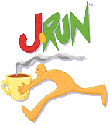|
|
|
 JRun Pro V2.3.3 for Windows 95/98/NT
JRun Pro V2.3.3 for Windows 95/98/NTFrom the publisher:Run, originally released in July 1997, is a Web server plugin that adds the functionality of server- side Java to your current Web server. JRun allows you to run Java servlets and JavaServer Pages without having to purchase and install a new Web server -- it works in conjunction with your current server, whether it be Microsoft's IIS or Personal Web Server, Netscape's Enterprise Server, Apache, O'Reilly's WebSite, or StarNine's WebSTAR. JRun can also run standalone using its own integrated Web server. Sophisticated business applications can be developed using server-side Java. Best of all, Java servlets are an attractive alternative to CGI (Common Gateway Interface) or Perl scripts because servlets are platform independent, easier to develop, faster to deploy, and more cost-effective to maintain.
Java servlets are platform-independent, server-side programs written using the Java Servlet API, part of the Java Platform. Java servlets bring the power of "write once, run anywhere," safe network delivery, and scalability to server-side applications. Traditional server-side applications and extensions written in Perl, C/C++, or other languages can be replaced through the use of servlets. By using servlets as an extensible, well-defined cross-platform environment, sophisticated applications for the server become easier to develop, faster to deploy, and more cost-effective to maintain. Cost effective: servlets can be deployed on inexpensive Windows NT machines.
By using existing mature server technology, such as Web servers, in combination with servlets, sophisticated applications can be written to hide the complexities and platform-specific behaviors of the particular server implementation. Servlets save the developer from worrying about the inner workings of the server. Form data, server headers, cookies, and the rest are handled by the servlet API's underlying classes.
One of the biggest differences between today's server- side applications and servlets is performance. A single JVM runs on the server and the servlet is loaded once when it is called. It is not loaded again until the servlet changes, and a modified servlet can be reloaded without restarting the server or application.
The servlet stays resident in memory so it is fast. Static or persistent information can be shared across multiple invocations of the servlet, allowing shared information between multiple users. Servlets are also modular; each servlet can perform a specific task and can be tied together. In short, servlets can talk to each other.
Features:
- Incorporates full Java Servlet API.
- Includes JavaServer Pages support.
- Supports all major Web servers and computer platforms.
- Supports ability to run any Java Virtual Machine - including multiple, concurrent JVMs.
Key benefits over competitors:
- Breadth of platform & Web server support.
- Breadth of Java Virtual Machine support.
- Small footprint - embeddable - small-device ready.
- Technology leader - time to market leader.
- Scripting capabilities - JSP, CF Anywhere, WebL, JavaScript.
Additional features:
- Includes an integrated Web server.
- Dynamic Taglets.
- Presentation Templates.
- Page compilation.
- Dynamic servlet reloading.
- Servlet initialization parameters.
- Servlet chaining and filtering.
- Multi-homing (virtual server) support.
- Servlet tag support.
- Runs under any Java Virtual Machine.
- Session tracking.
- Runs under any Java Virtual Machine.
- Installation wizard.
- Sophisticated Swing-based administration application.
- 100% Java and completely cross platform.
- Remote administration.
Click here for more information or to order this software application.